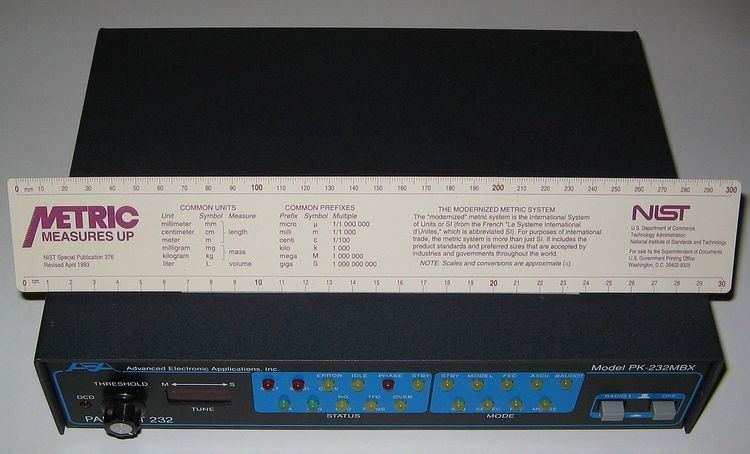 | ||
A terminal node controller (TNC) is a device used by amateur radio operators to participate in AX.25 packet radio networks. It is similar in function to the Packet Assembler/Disassemblers used on X.25 networks, with the addition of a modem to convert baseband digital signals to audio tones.
Contents
The TNC was originally developed by Doug Lockhart, VE7APU, of Vancouver, British Columbia, and popularized by the Tucson Amateur Packet Radio association with the TNC-1 and TNC-2.
Description
A typical model consists of a microprocessor, a modem, and software (in EPROM) that implements the AX.25 protocol and provides a command line interface to the user. (Commonly, this software provides other functionality as well, such as a basic bulletin board system to receive messages while the operator is away.) Because the TNC contains all the intelligence needed to communicate over an AX.25 network, no external computer is required. All of the network's resources can be accessed using a dumb terminal.
The TNC connects to the terminal and a radio transceiver. Data from the terminal is formatted into AX.25 packets and modulated into audio signals (in traditional applications) for transmission by the radio. Received signals are demodulated, the data unformatted, and the output sent to the terminal for display. In addition to these functions, the TNC manages the radio channel according to guidelines in the AX.25 specification.
Current status
TNCs were uniquely necessary when home computers lacked the sophistication needed to simultaneously manage a network connection and communicate with the user. They are still used today throughout a very popular position reporting network known as Automatic Packet Reporting System (APRS) on 144.390 MHz (in Europe 144.800 MHz).
Powerful desktop computers are commonplace in amateur radio stations. Software modems using the computer's soundcard have lowered hardware requirements even further. However, with their lower cost comes additional tweaking in order to make them work properly, and they often do not provide the decoding capabilities at low Signal/Noise ratios. Some handheld and mobile VHF radios currently on the market incorporate TNC abilities within the radio itself in support of the APRS protocol.
Many TNCs are still in use, especially in unattended stations where reliability is important. The importance of location to the APRS system has fueled development of a new generation of small low-power TNCs often integrated with a GPS module for use in mobile tracking stations.
APRS digipeating protocols require specific naming conventions, and older TNCs may not have the required support to be used as a digipeater. However, almost any TNC can be pressed into service for Home or Tracker use. TNCs that were clones of the popular TAPR TNC-2 may be upgradeable via the UIDIGI firmware project.
TNC/Radio data ports
Although typically described as data ports, the interface between a radio and a TNC is almost entirely analog audio (plus lines for PTT and squelch). The connectors used for this purpose varies widely across TNC manufacturers, but modern radios that offer data ports have widely adopted the Mini-DIN 6-pin connector.
Also used are full-size DIN connectors, modular telephone (RJ) connectors, and combinations of mini- and micro-headphone connectors (typically on handheld radios).
Terminal data port
The interface between a radio and a terminal is typically a standard serial port — a DB-25 or DE-9 connector carrying asynchronous start-stop bytes with RS-232 signal levels. TNCs were originally designed to accept messages from a human typing on a dumb terminal. However, typically a human uses a more sophisticated software package running on a personal computer that sends messages to the TNC using the KISS (TNC) protocol or the 6PACK protocol.
